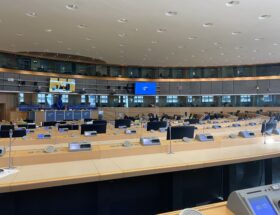Öresund Bridge, the border between Sweden and Denmark. Photographer: Johan Nilsson Credit: Ritzau Scanpix
Written by Isla Storie and Jamie Szmitz
Fleeing your own country, your survival dependent on seeking refuge in another, can be a frightening, uncertain process as it is. But what happens when a country known for its open-door approach to accepting refugees starts to close that door, and the minds of its population with it?
A wave of change
Historically, Sweden has adopted a very generous immigration policy, particularly for those impacted by conflict. Between 1984 and 2016, granting permanent residency permits to all asylum seekers and refugees was standard practice.
However, in the wake of the 2015 migration crisis, which saw over 160,000 refugees enter Sweden over three months -the largest number in the European Union per capita- hard-hitting changes were made. Temporary legislation, implemented in 2016, disregarded the country’s traditional open-armed welcome for a more cautious approach. 30 years of guaranteed residency came to an end when the government placed time limits on new permits in an attempt to reduce record numbers of asylum applications without closing the borders.

Henrik Emilsson, researcher in international migration and ethnic relations at Malmö University, outlined Sweden’s approach:
“You need to be the “good guy” in Sweden. We want to reduce migration but not seem like evil people, so there is a limit to what you can do in Sweden, as it has to be decent and an international role model”.
Where such a limit lies is as yet unclear, as this legislation was made permanent as part of the Swedish Aliens Act in July 2021. Residency permits were officially reduced to 13 months or three years, supported by existing procedures for integration into society.
“If you get asylum, you get a two-year programme to educate yourself and prepare for the labour market” explained Emilsson. This includes learning Swedish, tests for which, he stated, may become part of the application for permanent citizenship in the future:
“The tightening of restrictions has only just begun,” he added.
The measure of Malmö
Sweden’s third-largest city has had its fair share of immigration, with around one-third of its 348,000 inhabitants born in another country, and receiving the most refugees out of all Swedish municipalities in recent years. This was potentially boosted by neighbouring Denmark’s decision to keep its borders open during the 2015 crisis to allow refugees to travel through the country to reach Sweden via the Øresund Bridge, which connects the Danish capital Copenhagen with Malmö.
As easy as it can be to get there, staying is becoming a challenge. Many refugees arrive without a formal education, a potential hindrance to finding employment as a lot of jobs available in the city are specialised, often requiring a degree. This has a knock-on effect on finding and funding a place to stay, particularly in Malmö, where housing can be costly, all in all creating a vicious circle.

A cold Tuesday morning in Malmö sees immigrants and homeless people gravitate towards the warm embrace of Café David, run by Skåne City Mission. As the snow falls outside, they can enjoy a hot, healthy breakfast and meet other people in a safe environment. The buzz of conversation inside gives way to animated discussion among a group of men outside, the weather not a concern to them as they share their experiences since arriving in Sweden.
Emiliano came to Sweden from the African country Cape Verde and has struggled to integrate into Swedish society by getting a job:
“It’s not easy to be inside the system when you don’t have papers or competency in education.”
Another man arrived 11 years ago, escaping conflict in Somalia:
“I still haven’t been able to get a job, but I have a residency permit and a place to stay.”
While the attitudes to immigration were not brought up, some might argue they have become as cold as the weather outside.
Sweden and the European standard
Sweden’s stance on migration has changed drastically within the last decade. Anders Hellström, associate professor of political science at Malmö University, described the refugee crisis as a “discursive shift in Swedish politics.” The developments in Sweden can be compared to other European countries.
“When a lot of other European countries’ migration policies became gradually more restrictive, Sweden maintained a rather generous policy”, a hint towards Sweden accepting more refugees at this time than Denmark, who had implemented stricter rules.

Emilsson believes that Sweden is slowly becoming more restrictive all the time to reach the European level, but will never go as far as Denmark:
“That would be impossible.” Emilsson argued that Sweden’s political culture is based on the preservation of human rights, as well as working to encourage the EU to be more open, however the government cannot do this alone.
Alternatively, a more conservative stance on immigration has become generally accepted. According to Hellström’s observations, many Swedes are in favour of progressive forces for a more generous immigration policy:
“Sweden is determined to not follow the Danish example, but it’s difficult to tell which road it will take.”
Regardless of the magnitude of any decisions, however, the leader of the Moderate Party, Ulf Kristersson, claimed earlier this year that the issue of immigration is politically approached from a point of view which prioritises Swedes before protecting immigrants and refugees. The Sweden Democrats have previously defended their views by citing national interest in the sense that immigration can be a burden on the Swedish economy and welfare state.
The changes of legislation have coincided with the rise of the Sweden Democrats party. They have a strong anti-immigration ideology which alienated them from mainstream Swedish politics until the last decade. However, their increase in support has made them difficult to ignore for opposing parties. Emilsson stated that “it is still a very sensitive issue to cooperate with them.”
The responsibility of NGOs
Due to the legislation changes further complicating the residency permit application, an emphasis has been put on NGOs (non-governmental organisations) to help with the application process. Since it is largely argued that the new process is too complicated for some immigrants, especially with a language barrier or without the funds to employ a lawyer, it cannot always be done without assistance. Therefore, NGOs have had to step forward to support the immigrants who desperately need assistance to integrate into Swedish culture.
Skåne City Mission is an organisation which operates in Skåne County, which includes Malmö, and provides a variety of assistance to those in a vulnerable situation. As part of the wider Swedish City Mission organisation with centres all over the country, its main aim is to avoid and prevent all forms of exclusion. With background being a key driver to integration difficulties, supporting immigrants has naturally been woven into their work, according to press officer Eva Emmelin:
“It is harder now because people are less open to people that they think are not like them”, which is particularly prominent in the case of immigrants unable to find accommodation:
“There is a discourse now about our homeless, who are people born in Sweden”, she added, citing the dismissal of Sweden’s responsibility to help non-native homeless people solely because of their background.

Outside of the attitudes of society having an impact on integration, immigrants often do not know where to turn for help when they enter the system, unable to find healthcare, employment or a place to stay:
“It is hard to get affordable housing where the jobs are, that is the main issue. There are not many jobs for people without degrees” said Emmelin.
In Malmö, the organisation is able to provide immigrants and asylum seekers with legal and healthcare services, affordable meals and a sense of belonging to a community:
“The things you could get help with from the system has now moved on to NGOs…there is now an attitude of ‘no, you can’t get help here.’” Emmelin added.
Skåne City Mission once provided accommodation to those who needed it, however funding from the Swedish government was withdrawn, meaning the service could not continue.

The further complications in the application process have made integrating into a new culture even more challenging. Sweden’s integration processes for immigrants may not be changing, but the requirements for getting to grips with the language, the culture and leading a so-called “orderly life” still exist. Part of this is obtaining an education or finding employment on top of the process of getting papers in order, something the Skåne City Mission is no stranger to:
“Since the law changed so fast, a lot of people were left confused”, said Eva Emmelin, who explained that the City Mission has lawyers to help asylum seekers, particularly young people, with their papers. The new legislation was put in place without a transition period, so any residency permit applications made but not processed before the changes would be considered under the new rules. With the new time limit on residency permits the feeling is less “I can stay here now,” and more “they don’t really want me”.
Such views are spreading from the government and increasing in prevalence across Swedish society. In the annual Society, Opinion and Media (SOM) surveys, carried out by Gothenburg University, also in Sweden, to analyse public opinion, the question: “Should Sweden receive fewer refugees?” has been asked since 1990, but in the last few years there is no denying the trend. After a fluctuation in opinion throughout the 2000s, the number of those surveyed who answered in the positive in 2015 rose by 10 percent, continuing to creep up to 59 percent by 2020. This massively overshadowed the kinder opposing view- despite a small increase in 2015 in the view that fewer refugees would be a poor suggestion, just 22 percent agree as of 2020.
“There was empathy and a lot of people wanted to help the refugees but then the situation escalated, and nowadays we don’t want to go back there” said Anders Hellström. It is unclear whether these changes in attitude are brought about by the government’s manner of approaching immigration, but the numbers speak for themselves:
“You can quite clearly see a before and after. It has become much more accepted to have a restricted attitude to migration” he added.

The real impact
The biggest impact of the political and cultural changes of attitudes have been felt by the immigrants themselves. A 2017 report from the Swedish branch of Save the Children found that the influx of immigrants in 2016 led to a 200 per cent rise in calls to the helpline. The report found that one of the most frequent questions asked was “should I, too, kill myself so that Sweden understands that we choose death above going back?”
Outside of Skåne City Mission’s café in Malmö, the snow has stopped but the conversation continues. Emiliano from Cape Verde is one of many who has benefitted from the generosity provided by NGOs around Sweden:
“It’s a wonderful place. I come here, I buy healthy food for 30 krona and get warm clothes. They accept everyone and give them what they need.” The smile on his face says it all.
Despite the struggles faced by the Somalian refugee since his arrival, he has no regrets about moving to Sweden for a better life:
“Anything is better than the hell I faced in Somalia.”
The example of Sweden can be applied to many nations around the world. “It is the same mechanisms that made Trump president and passed Brexit” Emmelin noted:
“People are closing their minds, their hearts and their borders – we can see it everywhere and Sweden also.”
Infographic: https://create.piktochart.com/output/57082956-sweden-migration
VIDEO: https://youtu.be/Q8T9HBVwCMo







